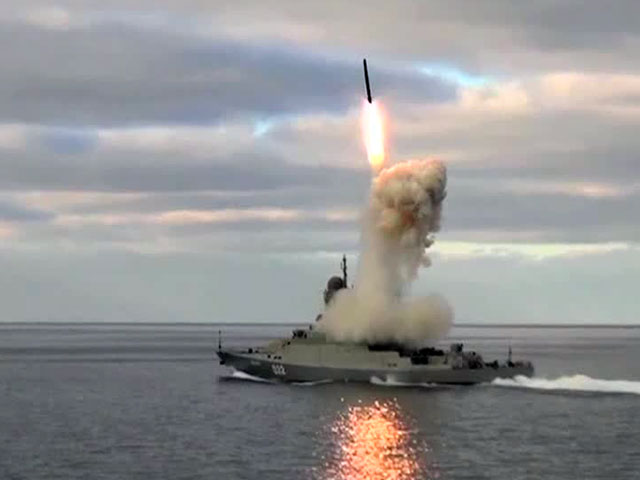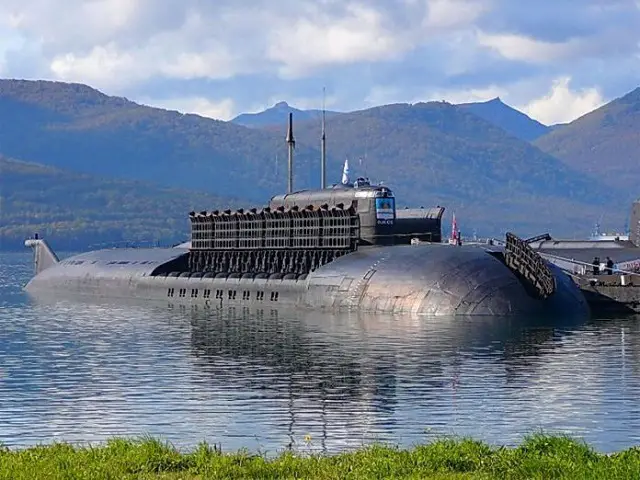|
|
|||
| a | |||
|
Naval Forces News - Russia
|
|||
|
|
|||
|
Presidential Decree Calls for More Cruise Missiles and Balanced Fleet for Russian Navy
|
|||
| Long-range precision-guided sea-launched cruise missiles (SLCMs) will be the main armament of the Russian Navy’s surface ships and submarines until 2025. This is stated in Presidential Decree No. 327 "On the approval of the Fundamentals of the Russian Federation’s state policy in the field of naval activities for the period until 2030," published on the official legal information website on July 20, 2017. | |||
|
|
|||
 The Buyan-M Corvette "Uglich" launches a 3M-54 Kalibr anti-ship missile during maneuvers in the Caspian Sea. The Buyan-M Corvette "Uglich" launches a 3M-54 Kalibr anti-ship missile during maneuvers in the Caspian Sea. |
|||
|
|
|||
| "Long-range precision-guided sea-launched cruise missiles will be the backbone of armament for the Russian Navy’s surface ships and submarines and coastal forces until 2025. After 2025, hypersonic missiles and diverse robotic systems, including autonomous unmanned underwater vehicles, will enter service with the Navy’s submarine, surface and coastal forces," paragraphs 43 and 44 of the decree say. In addition, until 2030, it is planned to develop a "naval aircraft-carrying complex," advanced surface ships and submarines (combat platforms), and next-generation deep-sea naval warfare systems. Among the objectives is to deploy naval robotic systems to perform a wide range of combat and support missions. "By 2030, the Russian Federation must have strong balanced fleets in all theaters of operation that will consist of ships intended to operate in near, far sea zones and ocean areas, as well as of naval aviation and coastal forces equipped with effective precision-guided strike weapons and will have an advanced basing and support system," paragraph 46 of the decree says. |
|
|
|||
 Russian Navy submarine Omsk (K-186), a Project 949A SSGN (NATO designation: Oscar II), with all missile hatches opened. The class is being modified to launch Kalibr SLCM. Picture via airbase.ru Russian Navy submarine Omsk (K-186), a Project 949A SSGN (NATO designation: Oscar II), with all missile hatches opened. The class is being modified to launch Kalibr SLCM. Picture via airbase.ru |
|||
|
|
|||
| According to the document, the main objectives in the field of the Russian Navy construction and development are to form balanced naval forces, maintain the combat potential of the naval component of strategic nuclear forces at a high level and build a qualitatively new configuration of general-purpose naval forces equipped not only with new and modernized weapons, but also with new and modernized military and special equipment. The decree notes that one of the priorities in the Navy’s fleet construction and development program in the medium and long term is to build up the fleet capabilities by building and upgrading attack nuclear submarines armed with missiles and torpedoes and diesel-electric submarines, guided weapon surface ships of different classes, naval aircraft, and various surface effect ships. One of the main strategic requirements for the Russian Navy is to "integrate interconnected and unified naval armament systems, ships, submarines, naval aircraft and coastal facilities into a single control loop." The decree especially emphasizes the need to completely switch the development and production cycle for key components of weapons and military equipment in the interests of the Navy to Russia’s scientific and industrial foundation. |
|||
|
|
|||
 Range of Kalibr family of cruise missile (scale models) on display at IMDS naval defense exhibition in Russia. Range of Kalibr family of cruise missile (scale models) on display at IMDS naval defense exhibition in Russia. |
|||
|
|
|||
| Among the main goals of the naval activities to prevent military conflicts and provide strategic deterrence, according to the decree, is to enable the use of precision-guided long-range weapons by the Navy ships against any potential enemy, to perform inter-theater maneuvers, including regular submarine voyages under the ice, to increase the combat and operational capabilities of the Black Sea Fleet through the development of a joint force grouping in the Crimea and to provide a continuous naval presence of the Russian Federation in the Mediterranean and other strategic areas of the world's oceans. "With the development of precision-guided weapons, the Navy faces a qualitatively new challenge: destroying the enemy's military and economic potential by hitting its vital facilities from the sea. The availability of a sufficient number of precision-guided weapons and the capability of using them in various ways will deter large-scale military operations against the Russian Federation. The key components of the strategic deterrence system are nuclear and non-nuclear deterrence. The general-purpose naval forces occupy an important place in meeting strategic deterrence challenges," the document says. © Copyright 2017 TASS. All rights reserved. This material may not be published, broadcast, rewritten or redistributed. |
|||







